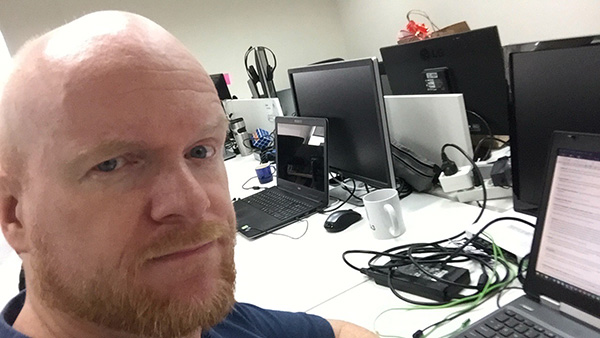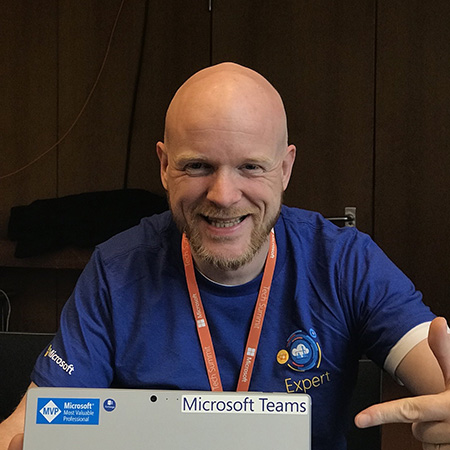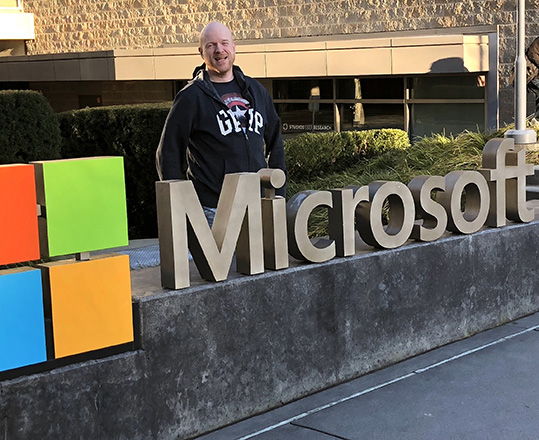Ask computer consultant Michel de Rooij which fictional character he most identifies with, and he doesn’t name someone from the Marvel Cinematic Universe or other “superhero.”
“I’d go with MacGyver,” he said, picking the title character from a popular 1980s TV show (and the recent reboot). “I like solving problems. I like helping people both professionally and outside of my work environment. That’s kind of my hobby. I love it.”
And while Michel might not employ a Swiss Army knife or chewing gum in his day-to-day work, he enjoys coming up with creative tools and solutions to the challenges posed by large Exchange implementations and other infrastructure tasks. It’s one of the reasons he’s earned the Microsoft MVP award every year since 2013.
“I’m a big fan of automation, so automating tasks or creating project or administrative tools using PowerShell is also what I love doing,” he said.
Interviewed from his home in the Netherlands, Michel talked with us about his journey in technology, the challenges of the modern software release cycle, his favorite Office productivity feature, and why he’s been an Insider since the very beginning.

How did you first become interested in computers and technology, and how did you turn it into a career?
Michel: When I was younger, a few of my uncles had early computers, including a Commodore 64. In high school, I started learning Basic through manuals and magazines, and after heckling my parents, I got a Commodore 64 at home. I was fascinated by the ability to program these devices. I got into the C64 demo scene, where I coded, wrote music, and created graphics with a group of people. Then, things switched to Amiga, and shortly after I went to university.
Since working on things like Pascal and C assignments using a PC emulator was not the best experience, I saved up for a PC. This was also a better fit for getting more programming experience for enterprise applications at that time. So I got my bachelor’s degree in software engineering, and after several different internships, I got involved in the infrastructure side of things. I found it a little bit more interesting than the development side, so I stuck with that.
Eventually, I worked on a project related to Exchange, and I developed a love for email-related things. The rest is history! Of course, now I also work on a lot of cloud-related things, because my customers often work in hybrid environments. I also do work on the client side of things, especially Outlook and Teams.
Why did you become an Office Insider?
It’s mainly to see things first and get an idea of what’s coming. I try to keep ahead of things, and I love exploring to see what’s new.
I’ve been an Insider since the beginning [2016]. And, one thing I’ve noticed is that the release of new features seems to have sped up a lot; it’s harder to keep track. Some of my customers struggle with the cadence of the new releases. This is not Office Insider-specific, it’s the whole cloud software model. So being an Office Insider helps me keep up with all the changes, and then I can help my clients with that.
What’s a recent Office feature or innovation that has helped make you more productive?
I really like the Dictate feature in Word. When I have an idea for a blog post or something, I can open Word and just go, “blah blah blah.” The app captures what I’m saying and generates a transcript that I can then use as the basis for a document. Of course it’s not perfect, missing all sorts of things, but it does give me rough outline and helps get my project started.
This allows me to produce the content more quickly, in a more natural way, without worrying too much about typing. Because if I’m typing and I see a typo, it distracts me from what I want to say. When you’re dictating, you are not focusing on what’s in the document, so it’s more natural and less distracting. Then I can edit it later; this really helps me save time.

Can you talk a little about why you created your blog EighTwOne?
The idea behind it was to share problems I encounter in the field, or questions that customers have. The hope is that by publishing them, it can help other customers or people dealing with the same issues. Frequently this also involves some commands or scripts, which I then also publish, hopefully saving people time when they want to achieve the same thing.
If customers have questions about something, all I need to do is send them a link to the article. It also functions as a collective memory, because sometimes you search for a solution and end up on your own blog. You’re thinking, “I saw something similar a few years ago” and you look it up and it’s there.
What is one word to describe the way you work?
“Pragmatic.” (The Dutch word is “pragmatisch.”) In my work, there is always the danger of projects getting bogged down by the desire to be perfect. While striving for perfectionism is OK, resources and time are usually limited. This is a field of tradeoffs where sometimes the imperfect result is “good enough,” because working on the remaining 5 to 10 percent would require a disproportionate amount of effort or resources.
In the cloud software world, this may also mean working towards a solution that you already know will lack certain features. But often things can be mitigated through instructions or adoption, or they may become available later. Working with these uncertainties makes one pragmatic, looking at the big picture and getting things done, and worrying less about details that might get blown out of proportion.
Be sure to sign up for the Office Insider newsletter and get the latest information about Insider features in your inbox once a month!
